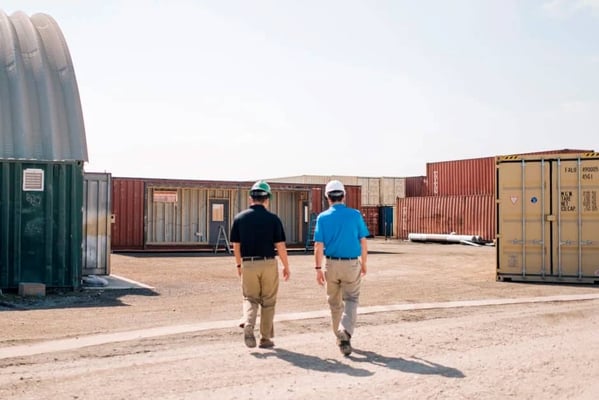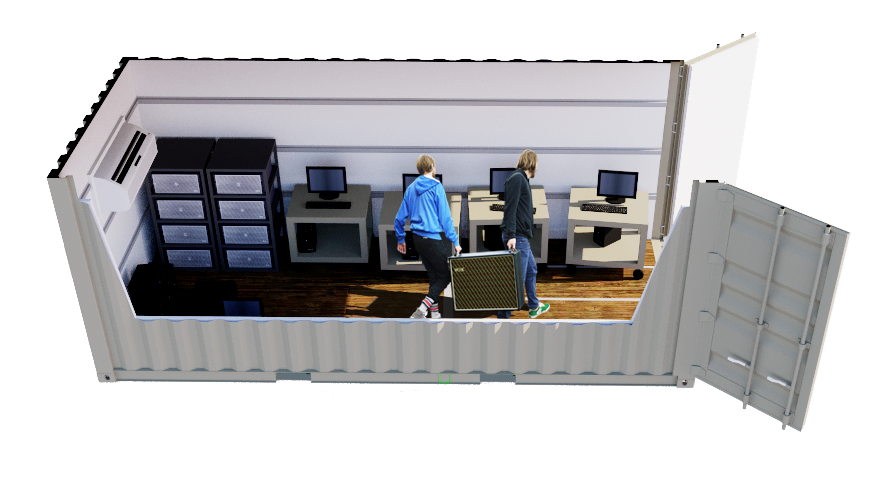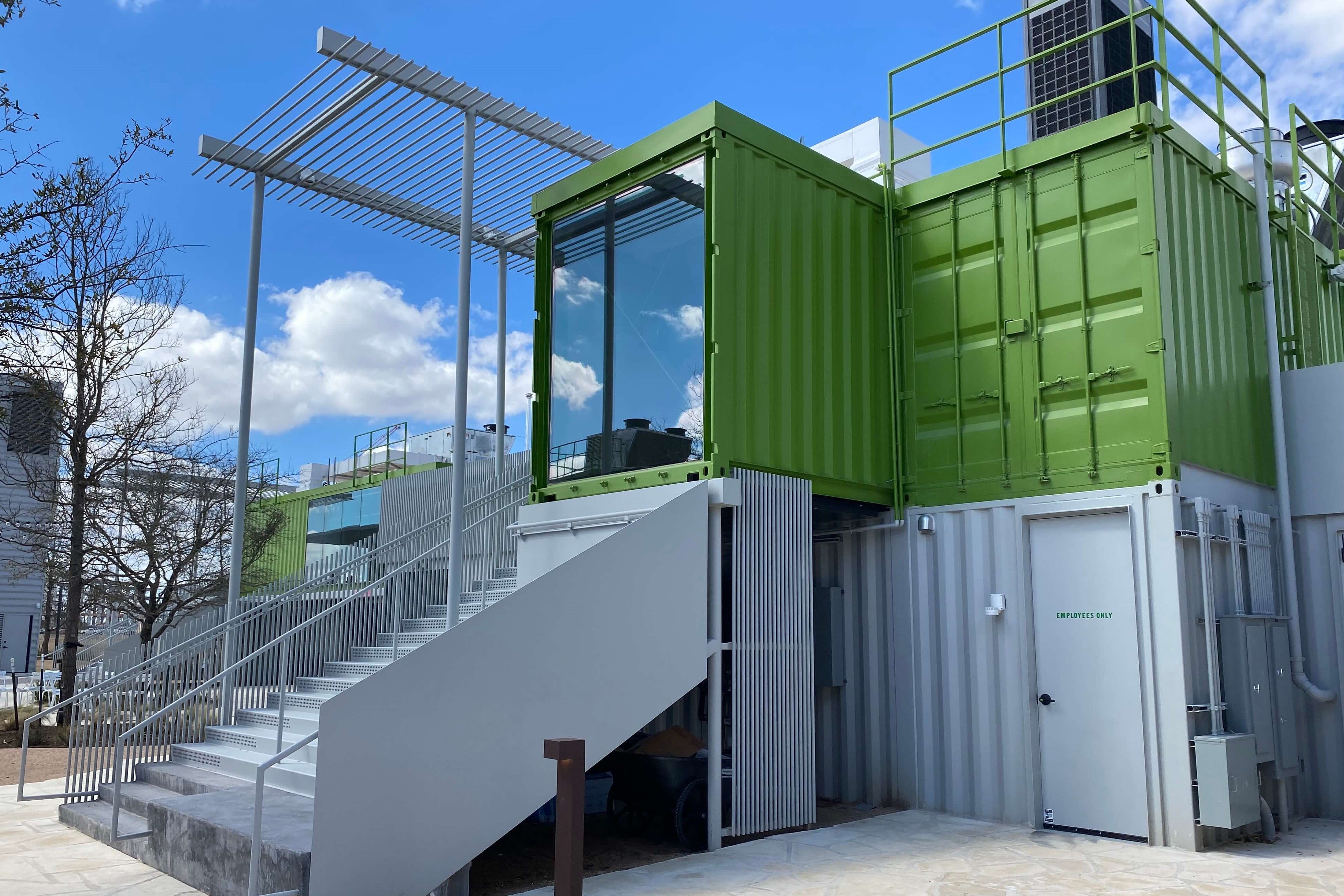What Architects & Engineers Must Know About Shipping Container Design
 Marissa Morin | Mar 3, 2021
Marissa Morin | Mar 3, 2021

Join Brian Dieringer, Co-founder and Executive Vice President of Products here at Falcon, as he answers important questions about shipping container design for architects and engineers.
Where does a shipping container get its structural integrity?
"The container is made to carry its load through the four corners at the bottom and then pick-up loads from above at the four corners at the top. So, without additional steel, all the weight is transferred out to those four corners. The side rails and the ends don't touch the ground or touch your foundation at all without extra reinforcing. The walls and the ceilings transfer loads out to those corners and any impairment to the sides have to be reinforced with additional steel or other measures.”
What happens when you cut into a shipping container?
“When you remove the sides of a container, the floor can turn into something like a trampoline – there's a lot of spring to it. The roof line will start to sag because without the sidewall, there's nothing to hold it up. So, there's a few things that happen. The biggest thing is that the corrugated wall sections and the stamp roof panels – if they're not there to carry some loads around – need reinforcing and additional steel to carry those loads.
It's important to know that once you remove a section of sidewall or even a roof panel, it's not going to stay in the same rigid form as it was before. And the other aspect to keep in mind is that the steel on the side walls is heavy. I've seen some interesting designs that try to utilize that steel for awnings or maybe even for a drop-down doorway, much like the Millennium Falcon. And that's a pretty hefty situation to deal with, so think hard about those kinds of designs.”
Do manufacturers need to reinforce shipping containers once they cut into them?
“What we've learned over the years, working with a number of structural engineers, is that there are some really clever ways to reinforce containers and keep the essence of the container intact. But, if you start cutting away components of the container, you're going to need to reinforce them to make sure you're developing a safe and functional building space.
We’ve worked with a number of architects and structural engineers, and we’ve learned that when we get into permanent modular construction – using lots of containers to form a multistory building – it's best to have an experienced engineering firm that has good models for taking advantage of the strengths inherent in the components of the container.
When we're working on permanent modular construction projects, we typically use containers that fall under our evaluation service report with the International Code Council. And these containers are distinguished in that we know everything about all the structural elements, all the materials used, the dimensions, and we have worked with the ICC to get them certified under AC 462 - an acceptance criterion for using containers of structural building elements. Working with these containers and design professionals that are familiar with container construction, we come up with efficient and attractive designs for building permanent modular structures.”
What would an engineer need to know before designing with shipping containers?
“Well, from a structural standpoint, the material properties and the dimensions involved are core to the analysis. So, with our AC462 containers, we know everything about how they're manufactured and inspected and certified at the original plant. We're happy to provide those details on specific models of containers of various sizes so that the analysis can be as efficient as possible.
Now, from an MEP standpoint - mechanical, electrical, plumbing - there are some considerations around dimensions as well, especially when it comes to plumbing. You know, how do you get your pipes to fit? In these multi container permanent modular construction projects, you have to bear in mind that these containers start with an exoskeleton in place. So, in a very real way, we're working from the outside in to finish out spaces. And that has implications when you're routing pipes and wires and even air conditioning components. Those are the kinds of things we want to encourage design professionals to look at carefully, the shipping container spaces and the impacts of those spaces on the design.”
What should an architect know before designing with shipping containers?
“So, for individual units as well as for modular construction, it's important to understand structural integrity. There are some fascinating design elements that come out of components of the container, but if you decide to use part of the sidewall as a big swinging door, understand that's really heavy steel and it's going to take a lot of reinforcing to replace that. Another aspect to consider is that the dimensional constraints of the container are expensive and difficult to change. We found the designs that are most successful embrace those little constraints and find creative ways to enhance the spaces created by the containers of whether it's multiple containers or spaces between containers.
There's a lot of creative things that can be done. Also, like with the considerations for MEP engineering, it's important to recognize that we're starting with an exoskeleton working our way in, so that can affect things like fire rated assemblies and how partitions get constructed in the space, so have that in mind and think ahead. Sometimes exposed or industrial looking elements can create some challenges when it comes to spaces between modules or between living units.”
Learn More About Modified Shipping Containers
Interested in learning more about modified shipping containers? Continue your research by viewing our free, downloadable guides. If you have additional questions or inquiries, reach out our container experts at 877-704-0177 or emailing Sales@FalconStructures.com.
SUBSCRIBE
- Shipping Container Modifications
- How-Tos
- Workspace
- Commercial Construction
- Multi-Container Buildings
- Storage Solutions
- Industrial Enclosures
- Bathrooms & Locker Rooms
- Oil & Gas
- Climate Control
- Green Building
- Living Space
- Industry Insight
- Military & Training Facilities
- Water Treatment Solutions
- Energy
THINK INSIDE THE BOX®
WITH OUR BLOG
Get everything from shipping container basics, to detailed how-tos and industry news in our weekly blog. Stay inspired and subscribe!
RELATED BLOGS

How Shipping Container Product Lines Make Life Easier
Paige Welsh | Feb 8, 2018 | 3 min read
READ MORE

20 Things We Love About Falcon: 20th Anniversary Edition
Marissa Morin | Feb 8, 2023 | 5 min read
READ MORE

What A General Contractor Should Know Before Building with Shipping Containers
Marissa Morin | Jun 1, 2022 | 3 min read
READ MORE